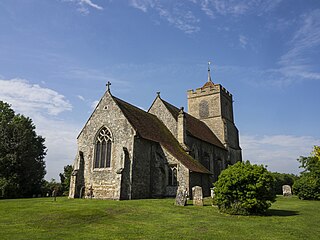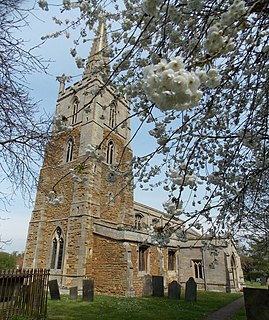
St. Mary's Church, Walthamstow, is a Church of England parish church in Walthamstow Village, a conservation area in Walthamstow, East London. It was founded in the 12th century and is still a working church. It retains over one hundred and fifty brasses and monuments, the oldest dating from 1436, though all that now remains of the original Norman church is some pillar bases and the chisel marks on them.

Wittering is a village and civil parish in the Soke of Peterborough in the East of England. The village is about 3 miles (5 km) south of the market town of Stamford in neighbouring Lincolnshire and about 9 miles (14 km) west of the City of Peterborough.
Buckland Brewer is a village and civil parish in the Torridge district of Devon, England, 4.7 miles south of Bideford. Historically the parish formed part of Shebbear Hundred. According to the 2001 census it had a population of 777, increasing to 794 at the 2011 census The village is part of Waldon electoral ward. The population for this at the same census was 1,679.

St Mary's Church is an Anglican parish church in the village of Newbold Astbury, Cheshire, England. It is recorded in the National Heritage List for England as a designated Grade I listed building, and its architecture has been praised by a number of writers.

St Oswald's Church is north of the village of Brereton Green, adjacent to Brereton Hall, in the civil parish of Brereton, Cheshire, England, on the banks of the River Croco. It is recorded in the National Heritage List for England as a designated Grade II* listed building, and is described as "an unusually complete late Perpendicular church". It is an active Anglican parish church in the diocese of Chester, the archdeaconry of Macclesfield and the deanery of Congleton. Its benefice is combined with those of Christ Church, Eaton, and St Michael, Hulme Walfield.

St Mary's Church is in Knowsley Lane, Knowsley Village, Merseyside, England. The church is recorded in the National Heritage List for England as a designated Grade II* listed building. It is an active Anglican parish church in the diocese of Liverpool, the archdeaconry of Liverpool and the deanery of Huyton. In the Buildings of England series, Pollard and Pevsner describe the church as being "largish" with "an intimate interior".

St Mary's Church is a redundant Anglican church in St Mary's Place, Shrewsbury, Shropshire, England. It is recorded in the National Heritage List for England as a designated Grade I listed building, and is under the care of the Churches Conservation Trust, the Trust designated St Mary's as its first Conservation Church in 2015. It is the largest church in Shrewsbury. Clifton-Taylor includes the church in his list of 'best' English parish churches.

St Cuthbert's Church is a redundant Anglican church about 1 mile (1.6 km) to the southeast of the village of Holme Lacy, Herefordshire, England. It stands in an isolated position at the end of a lane in a bend of the River Wye. It is designated in the National Heritage List for England as a Grade I listed building, and is under the care of the Churches Conservation Trust.

St Mary's Church is a redundant Anglican church in the village of Barnetby, Lincolnshire, England. It is recorded in the National Heritage List for England as a designated Grade I listed building, and is under the care of the Churches Conservation Trust.

St Benedict's Church is a redundant Anglican church in the village of Haltham-on-Bain, Lincolnshire, England. It is recorded in the National Heritage List for England as a designated Grade I listed building, and is under the care of the Churches Conservation Trust. It stands between the River Bain and the A153 road connecting Horncastle with Coningsby.

St Andrew's Church is a redundant Anglican church in the village of Buckland, Hertfordshire, England. It is recorded in the National Heritage List for England as a designated Grade II* listed building, and is under the care of the Churches Conservation Trust. The church stands at the highest point in the village to the east of Ermine Street, now the A10 road, between Royston and Buntingford.

St Nicholas is a Church of England parish church in Leeds, Kent first built in the 11th century with additions in the next five centuries. It is a Grade I listed building.

St Michael's Church is in Church Lane, Aughton, Lancashire, England. It is an active Anglican parish church in the deanery of Ormskirk, the archdeaconry of Wigan & West Lancashire, and the diocese of Liverpool. Its benefice is united with that of Holy Trinity, Bickerstaffe. The church is recorded in the National Heritage List for England as a designated Grade I listed building.

All Saints is a parish church in Ulcombe, Kent. It was begun in the 12th century and is a Grade I listed building.

St Mary's Church is in the village of Acton Burnell, Shropshire, England, and stands near the ruins of Acton Burnell Castle. It is an active Anglican parish church in the deanery of Condover, the archdeaconry of Ludlow, and the diocese of Hereford. Its benefice is united with those of St Andrew and St Mary, Condover, St Mark, Frodesley, and St Michael and All Angels, Pitchford. The church is recorded in the National Heritage List for England as a designated Grade I listed building.

All Saints Church is in the village of Claverley, Shropshire, England. It is an active Anglican parish church in the deanery of Bridgnorth, the archdeaconry of Ludlow, and the diocese of Hereford. Its benefice is united with that of Holy Innocents, Tuck Hill. The church is recorded in the National Heritage List for England as a designated Grade I listed building.

St Mary's Church stands on a hill in the town of Ellesmere, Shropshire, England. It is an active Anglican parish church in the deanery of Ellesmere, the archdeaconry of Salop, and the diocese of Lichfield. The church is recorded in the National Heritage List for England as a designated Grade I listed building.

The Church of St Mary the Virgin is a parish church of the Church of England in Baldock in Hertfordshire. Dedicated to the Virgin Mary, the original church on the site dated to about 1150 and was built by the Knights Templar before being largely rebuilt in about 1330 by the Knights Hospitaller. It is a Grade I listed building.

St Mary and St Peter's Church is a Grade I listed Church of England parish church dedicated to Saint Mary and Saint Peter in Harlaxton, Lincolnshire, England. The church is 2 miles (3 km) south-east from Grantham, and at the eastern edge of the Vale of Belvoir in South Kesteven.

St Peter and St Mary's is an Anglican church in Stowmarket, Suffolk. It is an active parish church in the Diocese of St Edmundsbury and Ipswich and the archdeaconry of Ipswich. Its earliest parts date from medieval times.



























